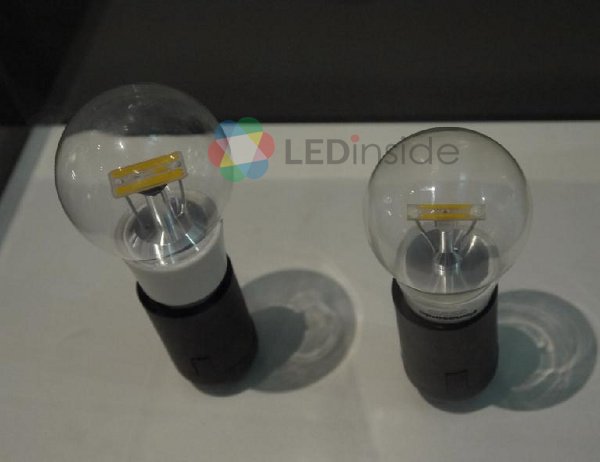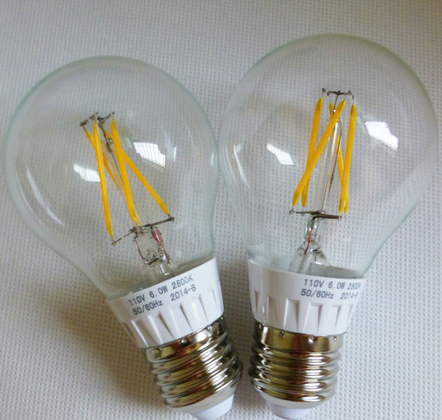The LED luminaire industry started to attract market attention, after Japanese manufacturer Panasonic launched its first glass omnidirectional LED bulb. The pioneer bulb had a transparent substrate with a dual-sided light emitting surface. Since then the industry luminaire design has evolved.
Taiwanese LED manufacturer Epistar’s launch of filament LED bulb design that resembles traditional incandescent bulbs has an omnidirectional lighting effect. European and U.S. consumers have warmed up to the bulb design, and it has been very popular among distribution channels. These factors have attracted many Chinese LED manufacturers to copy these designs, and filament LED bulbs can be seen at nearly every international LED lighting exhibition, and seen at nearly every booth.
 |
|
Panasonic’s LED filament bulb. (LEDinside) |
Challenges in the LED filament bulb market
LED filament bulbs are still mostly used in the decorative lighting market, or lighting replacement market, according to a LEDinside survey. Major LED lighting replacement product types include 450 lumens (lm) A19, A60, and A55 LED bulbs and 250 lm B35 or F35 candle lights. In 2014, LED filament bulb shipment volumes reached 43 million bulbs, and increased to 60 million to 70 million LED bulbs in 2015. Even though LED filament bulb volumes have grown, there is still a huge difference between shipment volumes of these bulbs and incandescent bulbs.
Even though there has been much talk in the LED incandescent bulb market, there has been little action. High LED incandescent bulb prices, thermal dissipation issues, and performance issues continue to obstruct the product from meeting market expectations of becoming a hot selling product.
 |
|
An Epistar client’s LED filament bulb product.(LEDinside) |
LED chip and transparent substrate price falls spur LED filament bulb market demands
However, the situation improved in 2015. The decisive element has been LED chips improved energy efficacy and lowered prices. Observations of LED filament bulbs cost structure reveals LED chip and its transparent substrate amount to 50% of bulb costs. Following spiraling LED chip and transparent substrate costs during first half of 2015, filament bulb costs have dropped. Free on Board (FOB) price dropped to US $ 3 in 2014 for A19 LED filament bulbs with a luminous flux of 450 lm, which has further declined to US $2 in 2015. In the end market, LED filament bulbs retail prices and its shelf prices hit the pricing sweet spot of under US $5, further stimulating LED filament bulb market growth.
LED lighting market order, LED manufacturers start to solidify supply chains through patents
Serious oversupply situations in the LED market in 2015 has led to intensive price wars among lighting manufacturers, and resulted in chaotic LED filament specs and pricings on the market. Manufacturers with LED patents have also used patent licensing to ensure their supply chain can operate smoothly. Manufacturers with LED filament patents include Japanese manufacturers Ushio and Nichia, Taiwanese LED chip maker Epistar, and Chinese LED manufacturer Ledison. Traditional international lighting manufacturers have also acquired related patents through mergers or patent licensing.
Epistar for instance acquired LED filament patents in U.S., Europe, China, and Taiwan in 2006. Most LED filaments on the market are made by gluing numerous LED chip layers together on a transparent substrate, which is a key Epistar patent. Epistar has also signed LED filament patent license agreements with a Chinese LED manufacturer it has invested in, Cosmoled. Epistar has also signed patent license agreements with China’s largest LED bulb manufacturer Leedarson, and aims to support strategic partners with its patent licenses. According to LEDinside observations, LED filament bulb market demands soared, and more lighting distribution channels and retail shops have started to receive LED manufacturers demands to respect LED patents. LEDinside projects LED filament patent wars are expected to take place during second half of 2015.
(Author: Roger Chu, Director, Research, LEDinsidehttp:// Translator: Judy Lin, Chief Editor, LEDinside)













